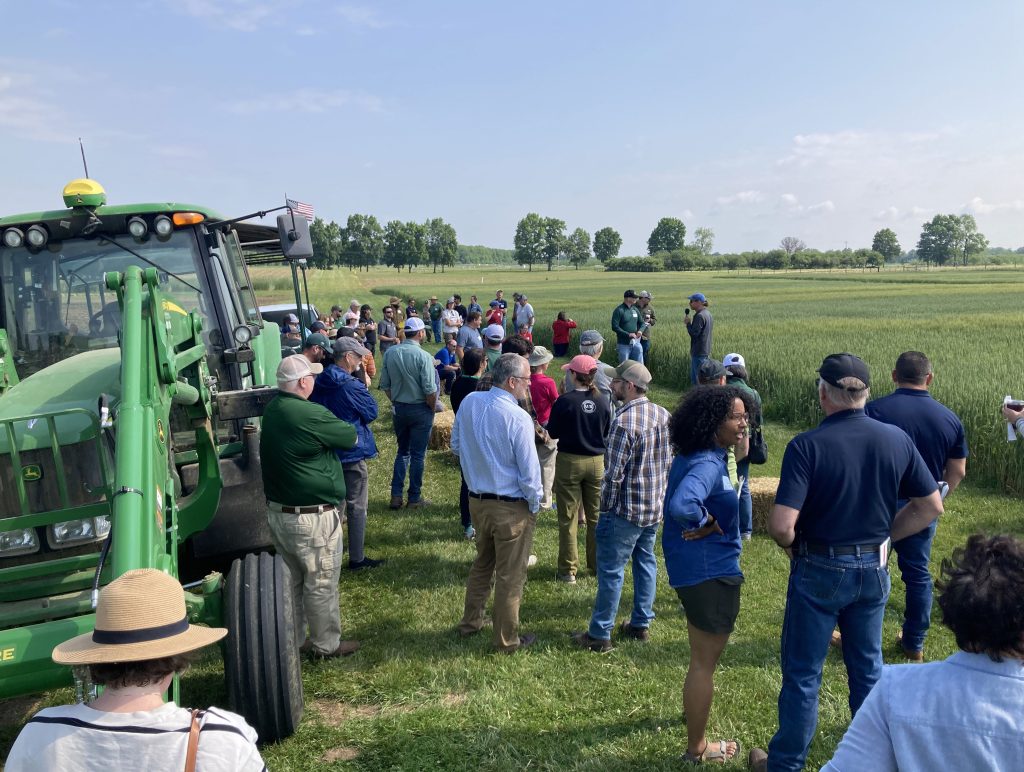Earlier this summer I went to a farmers market in Grand Rapids, Michigan, where I bought some ancient grains from Shady Side Farms. Little did I know that my summer job would bring me back to that farm.
Initially, when I knew I would be working with soil carbon and nitrogen metrics for the summer, I thought about how I struggle to appreciate the microscopic details. I am a systems and big picture thinker; I want to go out into the world and solve America’s messy, unhealthy, unsustainable food system, and yet I have had very little experience on farms or around farmers. A field trip was just what I needed to ground myself into the importance of looking at the microscopic.
Food Grade Grains Field Day

At the W.K. Kellogg Biological Station Long-Term Agroecosystem Research—LTAR—Food Grade Grains Field Day, I witnessed the crossroads between industry, farmers, and research scientists. It was incredibly encouraging to know that these cross-conversations are taking place amidst a food system of monopoly. We heard from a range of people such as local brewers, millers, bakers, crop breeders, conservation advocates, and both conventional and unconventional farmers with vastly different farm sizes. These economic and livelihood perspectives were what I had been missing in my microscopic world of soil health.
The talks were not only the interesting part; I learned what different breeds of rye, canola, barley, and wheat look like, and even more interesting was eavesdropping on reactionary conversations that farmers were having amongst themselves (tariffs seemed to be a common point of discussion). One particular farmer stood out to me as he seemed older but knowledgeable about soil health, nematodes, and so forth. My mentor pointed him out as a pioneering regenerative farmer in West Michigan. It only clicked later, but this farmer was the very same owner of Shady Side Farms, from whom I had bought ancient grain earlier.
Full circle

It was beyond a satisfying conclusion to the summer to end up back on Shady Side Farms, sampling soil. My memory may be rosy, but I think those soil cores might have been the easiest I took all summer. As we were sampling, the owner updated us on his soil reports, evident land profitability, and recent struggles with the impending drought. It was good to see him weathering it all with his healthy and profitable soil, working together like business partners. I left that farm feeling like I had accomplished something. I was helping him keep track of the health of his soil which would in turn impact his farm profit and livelihood that supports the West Michigan food system. I could geographically trace the connection back to my neighborhood in Grand Rapids from the Sprunger Lab at KBS. Turns out, the tiny numbers on the spreadsheet in grams per kilogram do actually translate to the real world.
Scientific research is funded by the public. For as long as I continue to pursue research, I want to make sure that not only the funding, but the research is stemming from public conversations. I want to be eavesdropping on farmer conversations and hearing the problems that they want solved. The academic leg seems useless to me when it is not connected to the body. But this summer at KBS, I was able to conduct lab work that applied to people and their livelihoods.
~~~~~~~~~~~~~~~~~~~~
Cherith Pickett is a student at Calvin University. During her summer at KBS, her mentor was Rachel Drobnak in the Sprunger Lab.
Cherith’s KBS summer was funded by the Doug and Maria Bayer W.K. Kellogg Biological Station Research Experience Award.
~~~~~~~~~~~~~~~~~~~~

A legacy of conservation; a commitment to sustainability.
3700 E. Gull Lake Drive
Hickory Corners, MI 49060
(269) 671-5117
info@kbs.msu.edu